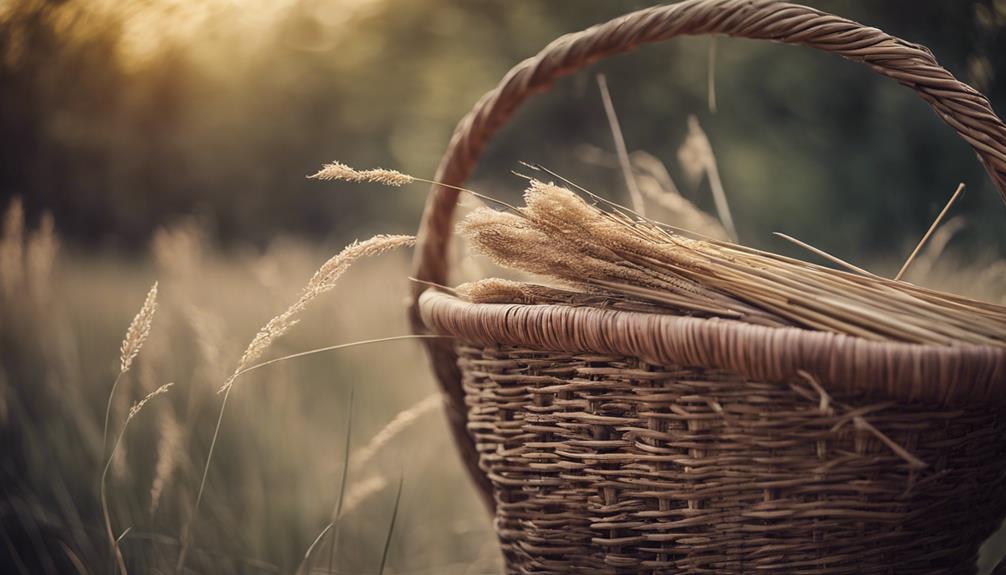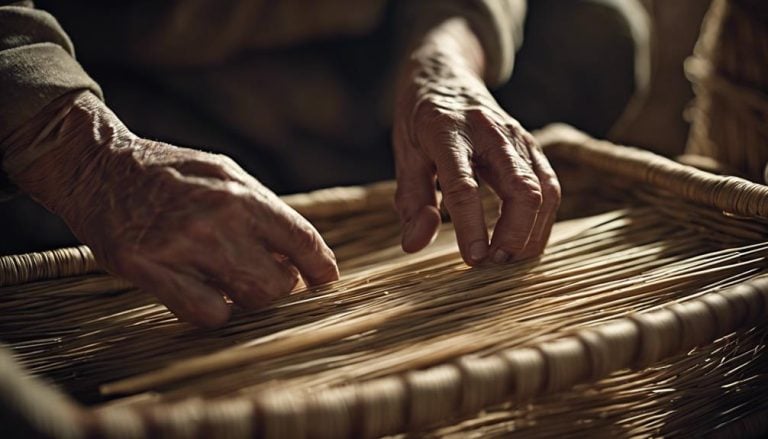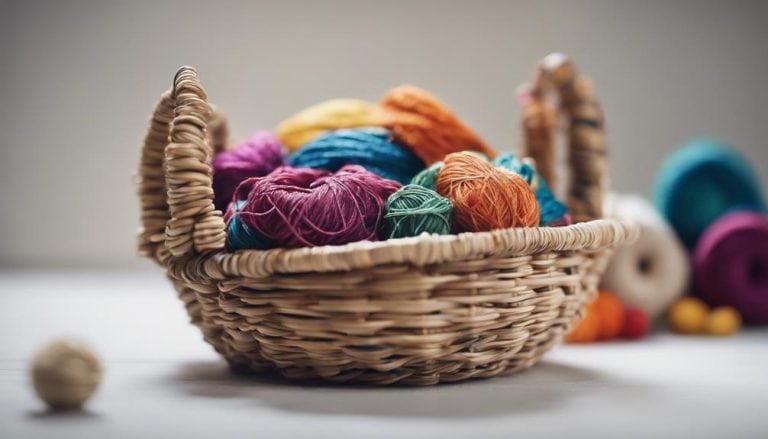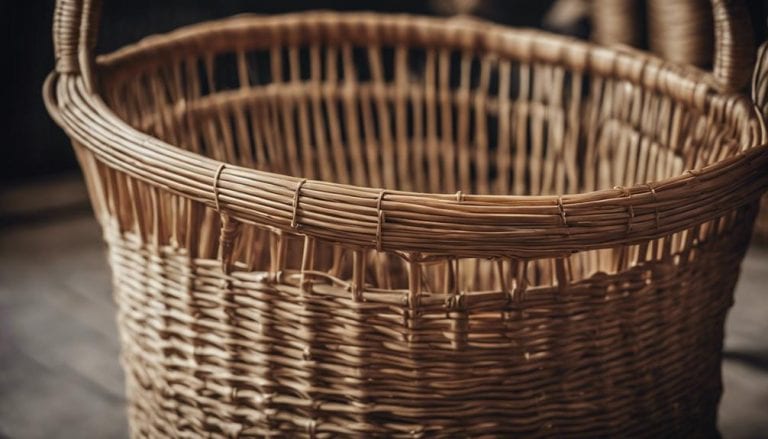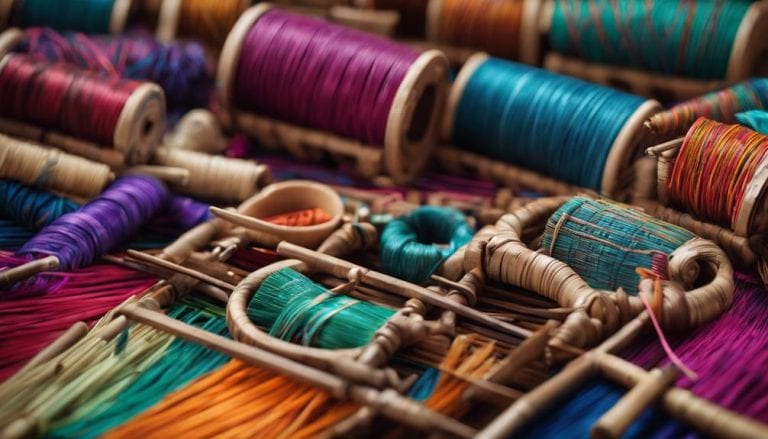Best Materials for Traditional Basket Weaving
I’ve often heard that the choice of materials can make or break a traditional basket-weaving project. But what makes one material stand out over others? Exploring the unique properties and characteristics of various natural fibers and vines used in basket weaving might surprise you.
The best materials for traditional basket weaving are typically natural fibers like willow, reed, or cane. These flexible and sturdy materials make them ideal for creating durable and functional baskets.
Each material brings its own story and challenges to basket making, from durability to flexibility. So, let’s unravel the secrets of these best materials and discover the intricate world they open up in traditional basket weaving.
Key Takeaways
- Traditional basket weaving materials like oak and willow offer flexibility and sustainability for intricate designs.
- Classic materials such as cane and willow provide durability, cultural significance, and design possibilities.
- Modern alternatives like reed and paper blend traditional techniques with eco-friendly options for creative baskets.
- Distinct characteristics of materials like bamboo and seagrass contribute uniquely to the artistry and functionality of baskets.
Natural Fibers for Traditional Basket Weaving
In traditional basket weaving, my hands instinctively reach for the supple tree bark, sturdy grasses, and resilient bamboo that will form the foundation of my creations. Deeply rooted in sustainability and craftsmanship, these natural fibers profoundly connect me to the earth.
Each strip of oak, willow, reed, or honeysuckle is carefully selected to enhance the artistic expression of my woven baskets. The natural connection felt through these fibers is unparalleled as I weave together strands nurtured by the elements. Flexibility is crucial as I intertwine these materials, ensuring a tight and secure construction that will stand the test of time.
The cultural significance of using natural fibers in traditional basket weaving goes beyond mere functionality; it embodies a way of life that values sustainability, craftsmanship, and environmental harmony. Each basket tells a story of tradition, artistry, and respect for the resources provided by the natural world.
Willow and Cane: Classic Basket Weaving Materials
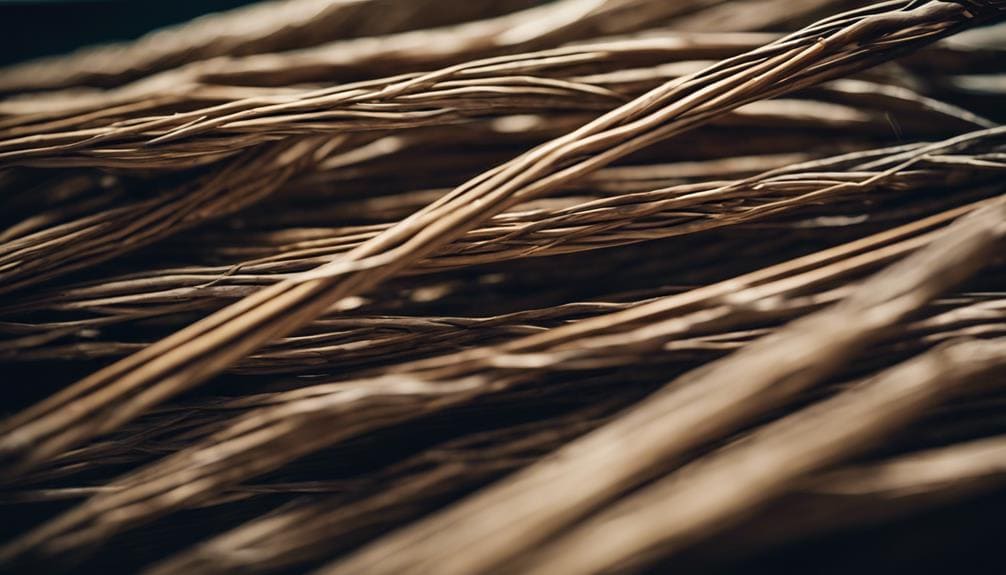
As I explore classic basket weaving materials, my hands are drawn to the timeless elegance and versatility of willow and cane. With its unique color variations and intricate patterns, Willow offers basket weavers a traditional yet captivating appeal. The flexibility, strength, and abundance of willow branches make them ideal for crafting durable and beautiful baskets.
On the other hand, cane, derived from rattan vines, brings sustainability and cultural significance to the art of basket weaving. Its durability and smooth texture make it a preferred choice for weaving intricate patterns and adding decorative elements to traditional baskets. Both willow and cane provide a wide range of design possibilities, allowing weavers to create baskets that serve a functional purpose and stand as art pieces with deep cultural roots.
| Willow | Cane |
|---|---|
| Unique color variations | Sustainable material |
| Intricate patterns | Cultural significance |
Reed and Paper: Modern Alternatives for Weaving
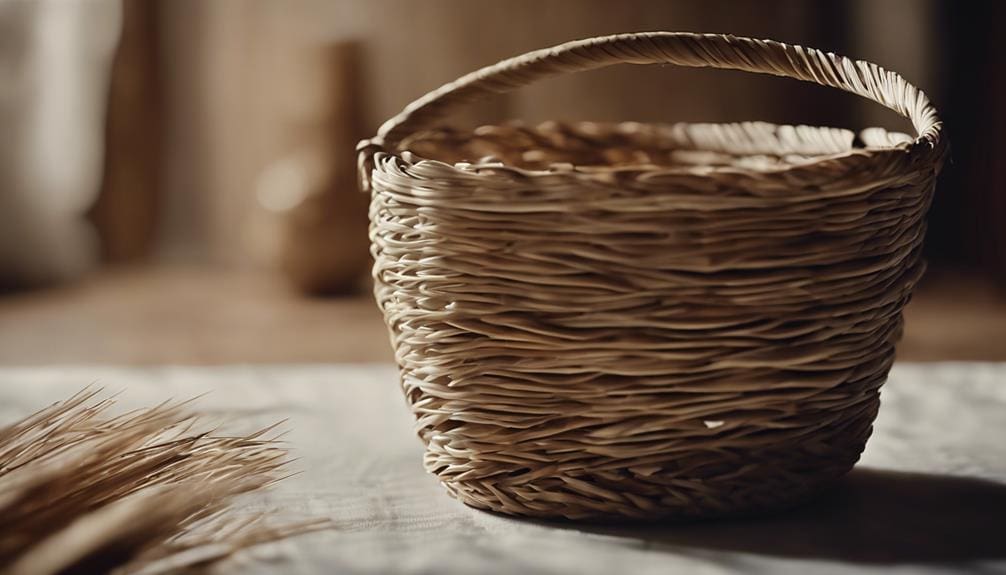
Embarking through basket weaving materials, one finds that reed and paper emerge as compelling modern alternatives, offering unique textures and design possibilities to elevate traditional weaving techniques. Reed, known for its flexibility and durability, has been a staple in traditional basketry.
However, the paper presents eco-friendly options and contemporary twists for weavers seeking innovative materials. With a wide array of color options and textures, paper strips can be manipulated and woven to create intricate designs, adding a modern flair to basket-weaving projects. Reed, available in flat, round, and half-round, provides various weaving techniques.
Both reed and paper allow weavers to blend traditional methods with modern materials, resulting in functional and decorative baskets that showcase a harmonious fusion of the old and the new. Marrying these materials opens up creative possibilities for those passionate about weaving artistry.
Characteristics of Different Basket Weaving Materials
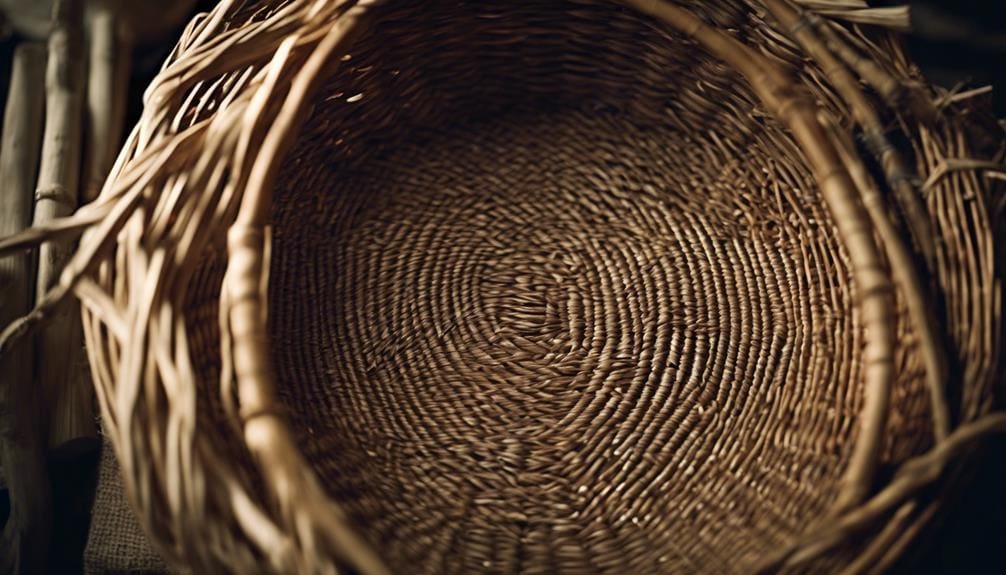
Among the diverse materials utilized in traditional basket weaving, each possesses unique characteristics that contribute to the artistry and functionality of the final woven creations.
- Willow: This material offers a wide range of color options, from pale yellows to deep browns, enhancing the visual appeal of baskets. Its flexibility allows for intricate weaving techniques, creating sturdy and beautiful designs.
- Bamboo: Known for its sustainability, bamboo is a durable choice for basket weaving. Its smooth finish adds a touch of elegance to the final products, and the availability of various sizes caters to different weaving projects.
- Seagrass: Renowned for its cultural significance, seagrass provides a natural look to baskets. Its pliability enables weavers to craft intricate designs easily, adding a touch of sophistication to the finished pieces.
- Rattan: With its unique texture and strength, rattan allows for versatility in creating different shapes and patterns in baskets. Its cultural significance adds depth and meaning to the craft, making each creation a tribute to tradition.
What Are the Traditional Materials Used for Basket Weaving?
Basket weaving materials guide will typically include natural materials like rattan, willow, bamboo, and reed. These traditional materials are known for their flexibility and strength, making them ideal for crafting sturdy and durable baskets. Fibers such as grasses, straws, and vines are commonly used in basket weaving.
Creating Stunning and Durable Baskets
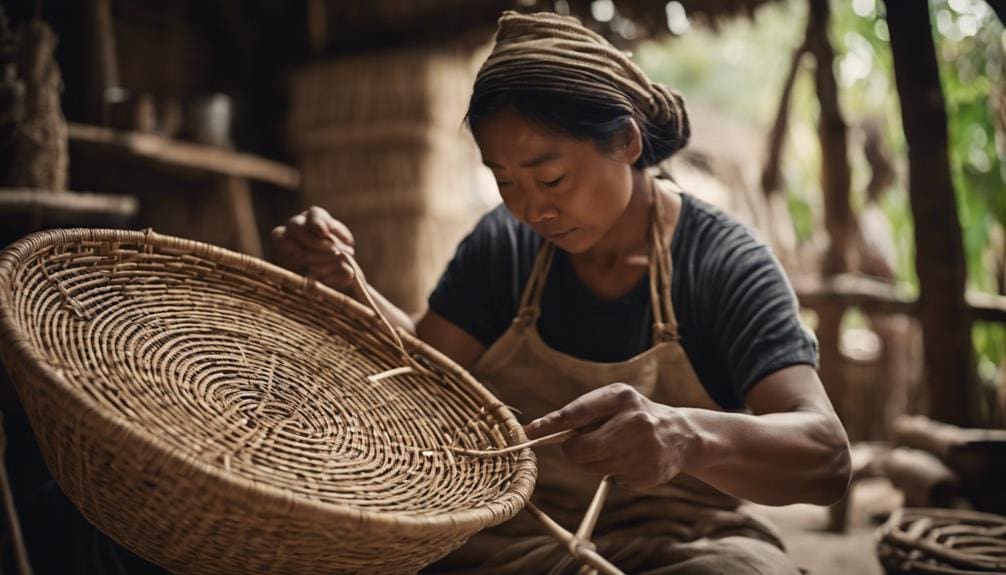
One can achieve stunning visual appeal and lasting durability in traditional basket weaving by carefully selecting and skillfully combining various natural materials. Sustainability is key when creating baskets that captivate with their aesthetics and stand the test of time.
Willow and bamboo, known for their fast growth and abundance, offer versatility and texture that enhance the beauty of woven creations. These materials, easily accessible in discount stores, provide a sustainable option for weavers seeking to craft eco-friendly pieces.
In addition to willow and bamboo, grasses, vines, and twigs are popular choices that add a unique touch to traditional baskets. Rattan-style basketry, utilizing materials like reed, is favored by many for its durability and flexibility. Rattan basket weaving supplies, commonly called reed, offer a wide range of options to weave intricate patterns and designs, creating stunning and durable baskets that reflect both craftsmanship and artistry.
Frequently Asked Questions
What Material Do You Use for Basket Weaving?
For basket weaving, I prefer natural fibers like rattan and seagrass. They offer sustainability and allow me to express cultural significance through artistic designs. Each material tells a unique botanical story, enriching my craft.
What Is the Most Popular Material in Basket Weaving?
For basket weaving, natural materials like willow and bamboo reign supreme. They offer a sustainable choice with their fast growth and abundant supply. The textures and colors of grasses, vines, and twigs provide endless creative possibilities in this timeless craft.
What Materials Have Traditionally Been Used to Make Baskets?
Natural fibers, like tree bark, grasses, bamboo, and vines, hold cultural significance in traditional basket weaving. Sustainability is key to allowing artistic expression. Native American cultures use willow, oak, reeds, and honeysuckle for their flexibility and durability.
Which of the Following Materials Is the Best in Basket Making?
Regarding basket making, plant fibers like willow and rattan reed outshine metal wires and synthetic materials. The natural reeds offer flexibility, durability, and a touch of tradition that cannot be replicated.
Conclusion
As I finish weaving my basket with the best traditional materials, I am reminded of the intricate tapestry of nature’s gifts. Like the kudzu vine that wraps around a sturdy oak tree, my basket tells a story of resilience and beauty.
Each fiber and bark in this creation represents a connection to the earth and our ancestors’ wisdom. Ultimately, I am left with a piece of art that honors the natural world and the art of traditional basket weaving.

